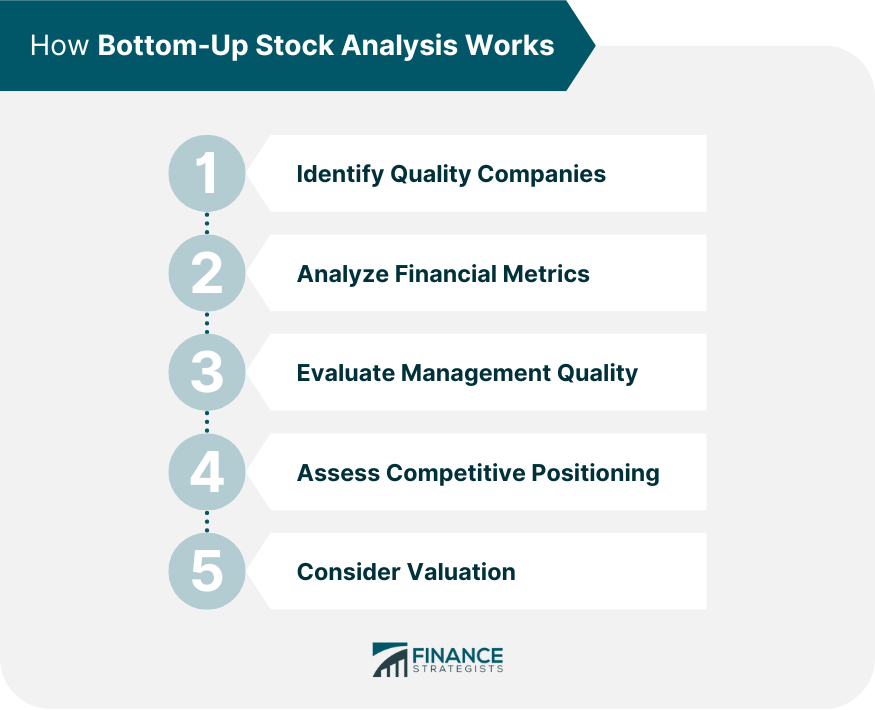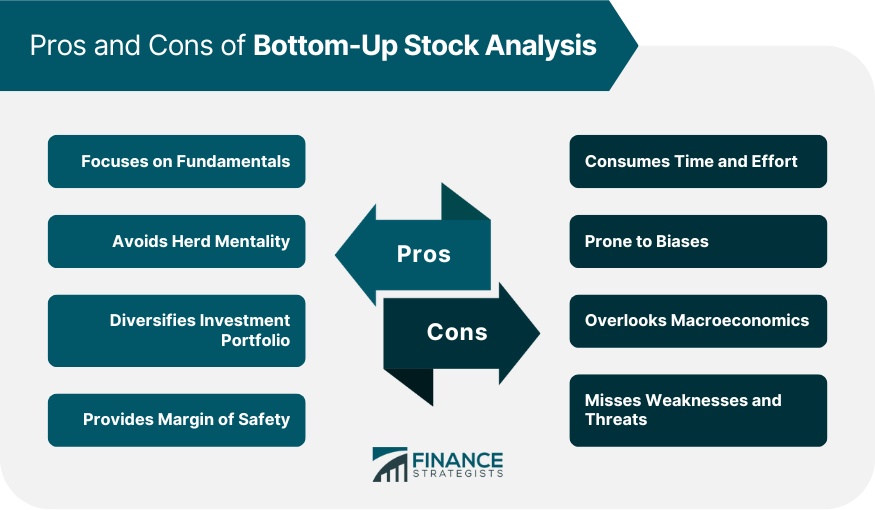Bottom-up stock analysis is a strategy used in investment analysis to evaluate individual companies and stocks based on their fundamentals, including financial statements, management, and industry conditions. Unlike the top-down approach that focuses on macroeconomic factors such as interest rates, inflation, and GDP growth, bottom-up analysis examines the microeconomic factors that drive a company's performance. The basic principle of bottom-up analysis is to find quality companies with strong competitive advantages, sustainable growth prospects, and reasonable valuations. By assessing a company's financial metrics, management quality, competitive positioning, and industry dynamics, investors can determine whether a stock is undervalued or overvalued relative to its peers or the overall market. The bottom-up investment strategy focuses on the intrinsic value of individual companies rather than external factors or market trends. The process of bottom-up analysis involves several steps that help investors identify undervalued companies and make informed investment decisions. Quality companies typically have a sustainable competitive advantage or moat, which is a unique advantage that allows them to earn high profits and fend off competition. Moats can come from various sources, such as economies of scale, brand recognition, patents, network effects, or switching costs. By identifying companies with moats, investors can select stocks with a higher probability of long-term success. Key financial metrics include revenue growth, earnings growth, profit margins, return on equity (ROE), return on assets (ROA), debt levels, and free cash flow (FCF). These metrics provide insight into a company's financial health, profitability, and growth potential. Investors should look for companies with a track record of consistent revenue and earnings growth, high profit margins, low debt levels, and positive FCF. A competent and experienced management team can make a significant difference in a company's performance and success. Investors should assess the management's track record, leadership style, strategic vision, and alignment with shareholders' interests. Companies with management teams that have a long-term vision and a history of delivering on their promises are more likely to create value for shareholders. A company's competitive position can affect its ability to generate profits and grow. Investors should evaluate the company's market share, customer base, pricing power, product differentiation, and barriers to entry. Companies with a dominant market position, loyal customers, strong brand recognition, and high barriers to entry are more likely to sustain their competitive advantage and generate long-term value. Valuation refers to the price investors are willing to pay for a stock relative to its intrinsic value. Investors should compare the company's valuation metrics, such as price-to-earnings (P/E) ratio, price-to-sales (P/S) ratio, price-to-book (P/B) ratio, and dividend yield, to those of its peers and historical averages. A company with a lower valuation than its peers or historical averages may present a buying opportunity. An overvalued company may pose a risk of a correction or a decline and should be avoided. Bottom-up analysis has several advantages that make it a useful strategy for stock picking and investment decision-making. Bottom-up analysis looks at an individual company's fundamentals rather than unpredictable and volatile macroeconomic trends. By focusing on company-specific factors such as moats, financial metrics, management quality, and competitive positioning, investors can identify undervalued stocks with the potential for long-term growth and profits. By conducting a thorough analysis of a company's microeconomic fundamentals, investors can make informed decisions based on data and facts rather than emotions and speculation. The bottom-up approach can help investors abstain from hype-driven investing that often leads to bubbles and crashes. It allows investors to build a portfolio of quality companies that can weather different market conditions and cycles. By selecting companies from different industries and sectors with unique competitive advantages and growth prospects, investors can reduce the risk of concentrated exposure to a particular sector or trend. A margin of safety can help protect investors from unexpected events such as economic recessions, industry disruptions, or management missteps that can cause a decline in a stock's price. Bottom-up stock analysis points out undervalued companies with a wide margin between their intrinsic value and market price. Investors should also be aware of the following drawbacks: Conducting comprehensive scrutiny of a company's financial statements, management quality, and competitive positioning can take several hours or days, especially for complex or unfamiliar industries. As a result, bottom-up analysis may not be suitable for investors who do not have the time or expertise to perform in-depth research. This analytical approach relies heavily on qualitative judgments and assumptions that can be subjective. For example, assessing a company's competitive advantage or management quality may vary depending on the investor's perspective or interpretation. As a result, the analysis may not be entirely objective or accurate. Bottom-up analysis may overlook aggregate factors affecting a company's performance and stock price. While bottom-up analysis focuses on fundamental factors that drive a company's growth and profitability, macroeconomic trends such as interest rates, inflation, and global trade can also affect a company's revenues, costs, and margins. The bottom-up approach may not provide a complete picture of a company's risks and challenges. While analyzing a company's fundamentals can reveal its strengths and opportunities, it may not capture its weaknesses and threats adequately. Factors such as regulatory changes, technological disruptions, or industry shifts can pose significant risks to a company's future prospects and affect its stock price. A classic example of bottom-up analysis is Warren Buffet and American Express. He thought that American Express was undervalued and had significant potential for growth, so he purchased 5% of outstanding shares. He eventually gained control of the board of directors and began pushing them toward structural reform and cost-cutting measures. This move led to American Express becoming much more profitable and eventually seeing tremendous stock growth. Today, Warren Buffet owns more than 20% of American Express. This case study is a prime example of how bottom-up analysis can yield long-term success. By carefully examining individual companies and investing in them when they are undervalued, investors like Warren Buffet have generated stellar returns over time. Bottom-up stock analysis is a valuable investment strategy that evaluates individual companies based on their fundamentals. The approach involves analyzing a company's financial metrics, management quality, competitive positioning, and valuation to determine whether a stock is undervalued or overvalued relative to its peers or the overall market. The advantages of bottom-up analysis include a focus on a company’s fundamentals, avoidance of herd mentality, portfolio diversification, and the provision of a margin of safety. However, this approach can be time-consuming and prone to biases. It may also overlook macroeconomic trends and other weaknesses and threats to a company. Investors must consider consulting a qualified financial advisor who specializes in wealth management services and can bottom-up approach and other analyses to help make informed decisions.What Is Bottom-Up Stock Analysis?
How Bottom-Up Stock Analysis Works
Step 1: Identify Quality Companies
Step 2: Analyze Financial Metrics
Step 3: Evaluate Management Quality
Step 4: Assess Competitive Positioning
Step 5: Consider Valuation

Pros of Bottom-Up Stock Analysis
Focuses on Fundamentals
Avoids Herd Mentality
Diversifies Investment Portfolio
Provides Margin of Safety
Cons of Bottom-Up Stock Analysis
Consumes Time and Effort
Prone to Biases
Overlooks Macroeconomics
Misses Weaknesses and Threats

Example of Bottom-Up Stock Analysis
Final Thoughts
Bottom-Up Stock Analysis FAQs
The bottom-up approach analyzes individual companies and stocks based on their fundamentals, while top-down investing examines macroeconomic factors such as interest rates, inflation, and GDP growth.
Bottom-up analysis can be applied to various securities such as stocks, bonds, and mutual funds. However, it may not be suitable for complex securities or those with limited data available.
Investors should review their bottom-up analysis strategy regularly, at least annually, to ensure that the company's fundamentals and competitive positioning have not changed significantly.
Common mistakes include failing to diversify one's portfolio, being too optimistic or pessimistic about a company's prospects, and relying on insufficient or outdated data. Investors must also avoid overlooking macroeconomic trends and ignoring industry disruptions or threats in making decisions.
Bottom-up analysis is more suitable for investors who are interested in building a portfolio of quality companies with long-term growth potential. Short-term investors may not have enough time to conduct the thorough research and analysis required for the bottom-up approach.
True Tamplin is a published author, public speaker, CEO of UpDigital, and founder of Finance Strategists.
True is a Certified Educator in Personal Finance (CEPF®), author of The Handy Financial Ratios Guide, a member of the Society for Advancing Business Editing and Writing, contributes to his financial education site, Finance Strategists, and has spoken to various financial communities such as the CFA Institute, as well as university students like his Alma mater, Biola University, where he received a bachelor of science in business and data analytics.
To learn more about True, visit his personal website or view his author profiles on Amazon, Nasdaq and Forbes.











